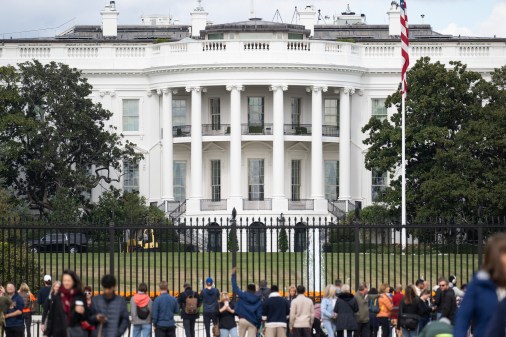A week after shutdown’s end, some federal workers’ job status remains in limbo

The return from the 43-day government shutdown has been marked by confusion and “chaos” for some federal workers who say they’ve received conflicting guidance or, in some cases, virtually no information about whether they still have jobs.
The shutdown was unprecedented not only for its record length but also for the mass layoffs of thousands of government employees. Now, the reopening is bringing its own challenges for the federal workforce.
Under an interpretation of Congress’s deal to reopen the government, laid-off workers in at least two agencies — the departments of Education and State — who had separation dates scheduled during the shutdown would be returned to their pre-shutdown status, advocacy groups argue. But they still have not received little to no official information from the agency, multiple employees told FedScoop.
Education’s civil rights office left in dark
It’s been more than a week since the government reopened, and numerous employees at the Education Department’s Office of Civil Rights (OCR) are still unsure about their job status.
“The Trump Administration is still ignoring the Continuing Resolution passed by Congress, which clearly requires the U.S. Department of Education to notify every worker it tried to unlawfully fire during the shutdown that they remain employed. That has not happened for all of the workers targeted in October,” AFGE Local 252 President Rachel Gittleman said in a statement to FedScoop on Thursday. “We call on Department leadership to immediately send official notice to every employee who is still in limbo.”
Congress’s deal to reopen the government provided short-term funding for agencies, but also included a provision that voided reduction-in-force actions that occurred during the shutdown. Its language appeared to primarily apply to RIFs initiated during the shutdown, but some federal employee unions, advocacy groups and legal experts argue it is broad enough to cover any RIF-related actions during the shutdown, regardless of when a RIF was first issued.
Nearly 265 OCR workers who were first laid off last spring received termination emails Oct. 14 — about two weeks into the shutdown — stating that a federal appeals court ruled in late September that the firings could proceed. They were told their final day would be Nov. 3, which also fell during the shutdown. AFGE 252, the union representing ED employees, maintains that the language is broad enough to include this group of employees.
There is an ongoing suit over the hundreds of initial layoff notices issued Oct. 10 during the shutdown. A federal judge paused those RIFs in a ruling weeks before the continuing resolution provision was signed into law.
In a status report filed in the case Friday, the Education Department informed the court that it also paused the March OCR RIFs “pending clarification” on whether the judge’s October injunction on RIFs applies to this group.
It does not mention the CR as a reason for the pause, and explicitly states that ED “has not rescinded the RIF notices to OCR employees for the March 2025 RIF.”
Despite the agency stating its position in a court filing, two OCR workers told FedScoop they had not received any information from the agency as of Friday on whether their layoffs are protected under the shutdown deal.
“I’ve just been sitting around, waiting to hear something from the department about what I’m supposed to be doing, if anything, or if I’m even there anymore, if I’m still employed there,” an OCR employee told FedScoop on Wednesday.
“It’s really strange when your employer doesn’t bother to tell you what your status is and doesn’t tell you that you’re able to work or that you should return to work or that you’re fired or what your situation is,” added the employee, who was granted anonymity to speak candidly.
A spokesperson for the agency said it “has brought back staff that were impacted by the Schumer Shutdown,” adding that it will “follow all applicable laws.”
Technical issues further complicate communications
Aside from a lack of communication, some federal workers said technical issues appeared to add to the confusion.
The OCR worker, one of hundreds laid off in the agency’s initial RIFs last spring, was on administrative leave until September, when they and other OCR employees were told they could return to the office in phases. The directive came months after a federal judge ordered in June that the OCR be restored to its former capacity.
The employee was in a group that returned to the office just days before the shutdown started.
During their brief return, the worker was reconnected to the email server. When they tried to log in to their government-issued laptop and account during and after the shutdown, their account was disabled, they said. When they reached the agency’s IT office upon the government reopening, they were told everyone in OCR had their accounts disabled without explanation.
“It’s just really, at the very least, unprofessional for the department to … not have any contact with people who are still their employees, who are ready to go back to work and want to get back to work and they’re just prohibiting that from happening for some reason,” the employee said.
Another OCR employee who was expected to return to work Oct. 6 said their colleagues were receiving updates through their ed.gov accounts, but this employee had been returned to official duty and therefore couldn’t access their email account.
When the employee reached out to HR, they were told they are authorized to use their government laptop to access their email, but the employee reminded them they haven’t had their equipment since being walked out of the office last spring.
“They have a piece of paper that says exactly what I turned in and the fact that they don’t know who has government equipment and who doesn’t, it’s a little scary but not a surprise at all, because the left hand is definitely not talking to the right,” the employee told FedScoop in an interview Thursday. “There’s so much of a breakdown in communication and they don’t seem to care if they get it right or not.”
State Department foreign service officers in limbo
At the State Department, foreign service officers who were slated to be separated Nov. 10 as part of a RIF announced in July are also looking for answers.
John Dinkelman, president of the American Foreign Service Association, a membership organization that advocates for foreign service officers, told FedScoop that in a union survey of potentially impacted workers, just about half of the respondents indicated they received a communication from the department that their leave had been extended.
But those messages also didn’t say that it was a result of the CR language and didn’t provide a date when the extended administrative leave would end, per Dinkelman, who is among the impacted diplomats.
The survey received responses from roughly 120 individuals, Dinkelman said. That represents about half of the 246 foreign service officers initially impacted by the RIF. Though the union has noted that while the initial number was 246, an unknown number had likely retired prior to the separation date.
While the extension of administrative leave is welcome for many, Dinkelman said that it complicates matters for other impacted workers who had jobs lined up or were retiring. In those cases, the CR again throws them into uncertainty.
“I know of individuals who were supposed to have retired on November 10, and who were informed that they could not be retired on that day because they had been placed on administrative leave,” he said.
The State Department didn’t respond to a request for comment about communicating with workers. In response to an earlier inquiry about the continuing resolution’s potential impact on the RIF’d foreign service officers, however, a State Department spokesperson said the July staff reductions were in “compliance with all legal requirements.” The statement called its RIFs “the most complex and tailored in federal government history” and said they were “designed to facilitate a more efficient, faster, and effective America First diplomacy.”
For impacted workers, the entire process of the department’s reduction has been frustrating.
“I can’t overstate how many messy errors State has made in all this,” one impacted foreign service officer told FedScoop. “Incorrect paperwork, deleting paperwork entirely, incorrect paychecks for some of us, conflicting messages for those who are retirement eligible.”
In addition to the issues with the RIF-related actions during the shutdown, the department also sent already RIF’d workers information about the furlough to their personal email addresses. At the time, the department blamed the issue on a data error, but workers continued to receive information after that incident.
SBA sends whiplash RIF notices
At the Small Business Administration, dozens of employees were laid off days before the shutdown and told their separation date was Oct. 28. But more than two weeks after the separation date passed, 77 SBA employees received a letter Nov. 17 informing them their RIFs were rescinded and they could return to work.
The letter, obtained by FedScoop, cited the CR and gave workers one day to inform the SBA of whether they planned to return to work Nov. 19, resign, continue with their voluntary retirement, or complete the retirement process through the Voluntary Early Retirement Application (VERA).
The letter’s wording appeared to suggest the SBA agreed the CR applied to those with a shutdown separation date.
But a day later, these employees received a two-sentence email informing them that the RIFs are moving forward.
“Notwithstanding any prior communication from the U.S. Small Business Administration, the September 29, 2025 RIF Notice and termination affecting your position remain in effect,” the second letter, obtained by FedScoop, stated.
Federal News Network first reported on the SBA’s reversal.
There “was no explanation,” one RIFed SBA employee told FedScoop on Friday.
Maggie Clemmons, the press secretary for SBA, told FedScoop the agency “determined that the most recent continuing resolution signed into law does not apply to any RIFs executed by the SBA.”
“Therefore, the RIF in question, affecting 77 positions, remains,” she added.
Unlike others on administrative leave, these 77 positions are considered officially separated from the agency, meaning they are no longer being paid during the holiday season.
“Because of the holidays, a lot of the employees were looking forward to having their jobs back, because then that gives them time to feel more comfortable buying things, purchasing meals, or just not having that burden on their minds or shoulders,” the RIF’d agency employee said.
Another RIF’d SBA worker told FedScoop they had a different job offer on the table that they declined after receiving the rescission notice.
“Never in mind would I have thought that this was tentative. They didn’t say we’re still waiting on our legal teams to interpret Congress or the law or the CR; it was yes or no,” the employee said Thursday. “I started making plans … and the next day, woke up again, new email.”






